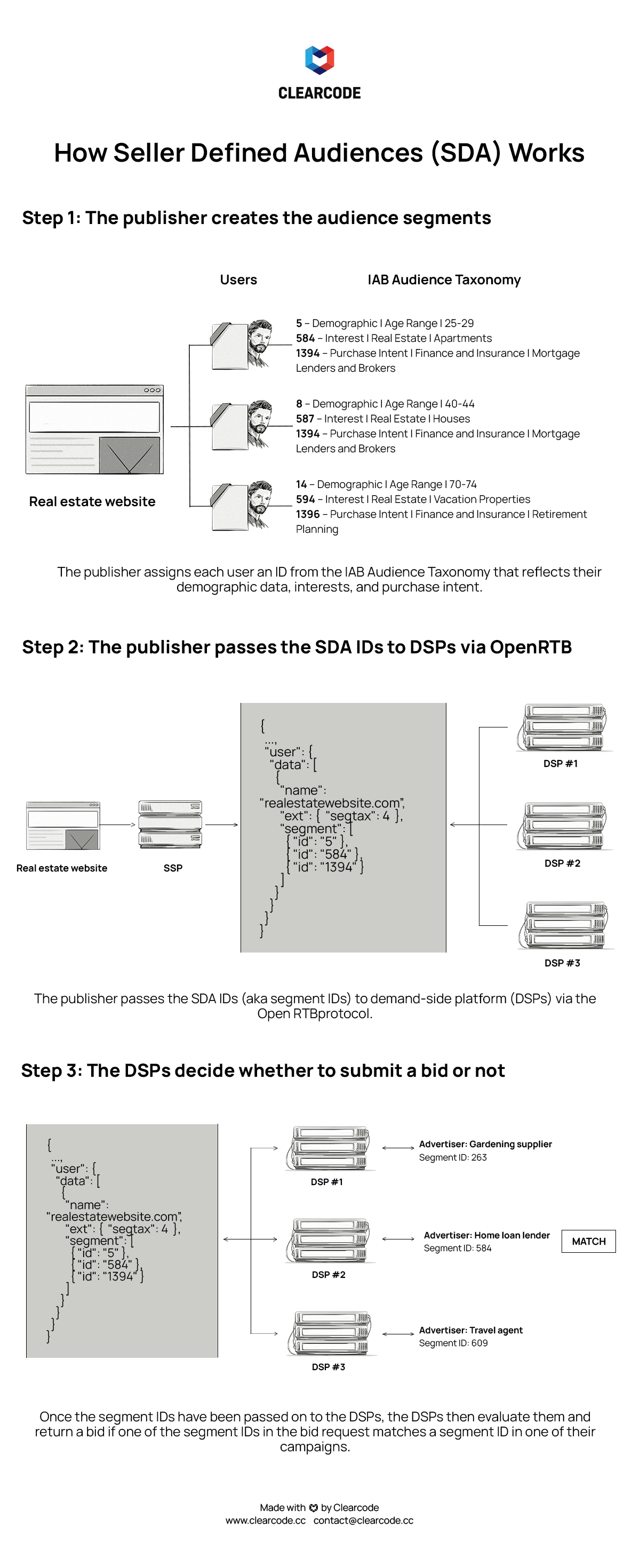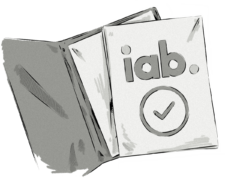Ever since Google Chrome announced that it would be shutting off support for third-party cookies, the race to find new solutions has been on.
One such alternative to third-party cookies comes the IAB Tech Lab in the form of its Seller Defined Audiences (SDA) standard.
In this blog post, we explain what SDA is, how it works, why it was created, how it differs from other alternatives, and the pros and cons.
Key Points
- Seller Defined Audiences (SDA) is a technical specification released by the IAB Tech Lab that allows publishers to monetize their audiences without needing to use a unique ID or reveal a user’s identity to advertisers.
- The IAB Tech Lab developed the specification to provide a solution to the diminishing availability of third-party cookies, while at the same time offer a privacy-focused alternative to ID-based identity solutions, such as third-party cookies and universal ID solutions.
- The SDA leverages other IAB Tech Lab standards, notably Audience Taxonomy, IAB Tech Lab Data Transparency Standard, and IAB Tech Lab’s Transparency Center.
- The IAB Tech Lab has designed the SDA specification to work with existing media-buying processes and standards — the OpenRTB protocol and Prebid.
- Publishers will be able to create and sell around 1,600 contextual audiences with SDAs.
What Are Seller Defined Audiences (SDA)?
Seller Defined Audiences (SDA) is a technical specification released by the IAB Tech Lab that allows publishers to monetize their audiences without needing to use a unique ID or reveal a user’s identity to advertisers. The IAB Tech Lab developed the specification to provide a solution to the diminishing availability of third-party cookies, while at the same time offer a privacy-focused alternative to ID-based identity solutions, such as third-party cookies and universal ID solutions.
SDA is the first specification from the IAB Tech Lab’s Project Rearc initiative.
Project Rearc aims to create new standards for companies operating in the programmatic advertising industry to address their demands for privacy and personalization. At its heart are user privacy and the efficiency of AdTech solutions.
We Can Help You Build an AdTech Platform
Our AdTech development teams can work with you to design, build, and maintain a custom-built AdTech platform for any programmatic advertising channel.
How Can Publishers Create Seller Defined Audiences (SDA)?
To avoid reinventing the wheel, SDA utilizes existing IAB Tech Lab standards to help publishers label their first-party data and help advertisers to recognize whether a user associated with a given SDA is a member of their target audience.
SDA is based on three pillars: IAB Tech Lab Audience Taxonomy, IAB Tech Lab Data Transparency Standard, IAB Tech Lab’s Transparency Center, and many smaller specifications.
The Audience Taxonomy categorizes audiences in a standardized way by assigning them to individual users. The IAB Tech Lab has defined more than 1,600 attributes within this taxonomy to help build various cohorts out of a publisher’s first-party data. Once those cohorts are big enough to anonymize, they can be dispatched in the bidstream using present objects within the OpenRTB protocol.
The Data Transparency Standard specifies how and when the data was obtained and indicates the quality of the data. Since the accuracy of this information is self-attested, the IAB has created a separate compliance tool that checks which trustworthy sellers are appropriately labeling their data.
The Transparency Center supports the Data Transparency Standard by enabling the posting of these data labels to a centralized resource that IAB Tech Lab members can review before purchasing a given SDA.
As a result, advertisers can determine which cohorts a person belongs to and the fineness of the data that informed the cohorts without any particular data being sent through programmatic streams.
If an advertiser wants to check if a given audience matches their target audience, they can refer to the corresponding data transparency label and view the details, such as data audience provider, audience segment, compilation method, and data source.

What Role Will IDs Play in Creating Seller-Defined Audiences?
Even though SDA doesn’t use unique user IDs, publishers can still create seller-defined audiences out of users that are associated with an ID. However, publishers will have to ensure that these user IDs are not connected with the SDA segments to avoid user identification.
Publishers can also use their existing data platforms, such as a data management platform (DMP) or customer data platform (CDP), to create seller-defined audiences using the first-party data stored in the platform.
What Data Can Publishers Use to Create Seller-Defined Audiences?
Because the IAB Tech Lab’s Audience Taxonomy contains three pillars — demographic, purchase intent, and interest — publishers can use data collected from registered and logged-in users to build SDA segments.
For example, if a user provides their date of birth when creating an account with a publisher, then this information can be used to populate the demographic part of the Audience Taxonomy. This can later be enriched with interest and purchase intent data as the user browses the website.
How Do Seller Defined Audiences (SDA) Work?
The IAB Tech Lab has designed the SDA specification to work with existing media-buying processes and standards — notably the OpenRTB protocol and Prebid.
The procedure for utilizing SDA is as follows:
- The publisher creates audience segments based on their first-party data.
- The publisher passes the SDA IDs to DSPs via OpenRTB
- The DSPs examine the segment IDs and decide whether to bid on the impression or not.
The image below illustrates how seller-defined audiences are created and passed onto advertisers.

Why Were Seller Defined Audiences Created?
Seller defined audiences were created to address the current privacy challenges in programmatic advertising and the declining availability of third-party cookies.
SDAs are one of the many proposed alternatives to third-party cookies, however, unlike alternatives like universal IDs, seller-defined audiences aim to balance ad personalization with user privacy.
Usually, a publisher would have two choices if they wanted to activate their first-party data and enable advertisers to bid on it:
- OpenRTB auctions: Publishers make the data available to advertisers by pushing user-level IDs from an SSP or DMP to a DSP.
- PMP deals: Publishers establish a private marketplace deal (PMP) whereby they pass the Deal ID from their SSP to a DSP. The Deal ID can be linked to specific audience attributes.
However, there are many privacy and business-related issues with these activation methods, which we outline below when discussing the advantages of SDA.
It’s because of these reasons that the IAB Tech Lab has stated that it won’t be creating an ID solution nor will it be advocating for the “broad collection, use or sharing of email addresses or phone numbers as IDs across the ecosystem.”
“SDA emphasizes the ability to strengthen the value of a publisher’s first-party data and at the same time improve user privacy. Publishers who choose to use the SDA standard can activate their first-party data for advertisers without sharing user identification information with external platforms.” — Piotr Banaszczyk, CEO of Clearcode.
How Do Seller Defined Audiences Compare to Universal IDs?
Universal IDs were initially developed to offer a shared identity for users to be recognized throughout the advertising supply chain with reduced amount of cookie syncing. Some universal IDs use data like email addresses and mobile IDs to create IDs, while others use probabilistic matching to create IDs. The fact that universal IDs are not limited to third-party cookies is crucial.
In other words, it is possible to build universal IDs using a range of both first-party and third-party data collected from online and offline sources, such as from point-of-sale (POS) and CRM systems.
However, universal IDs revolve around identifying individual users to power targeted advertising in the programmatic advertising industry. It’s this user-level identification that is the crux of the privacy issue in AdTech.
On the other hand, SDA revolves around not identifying individual users to power targeted advertising. To preserve privacy, users are placed into audience segments based on demographic data, interests, and purchase intent but their actual identity isn’t revealed to advertisers or their DSPs.
How Do Seller Defined Audiences Compare to Google Chrome’s Topics API?
Both Topics API and SDA form cohorts and share anonymized data with advertisers. However, the similarities end there. The main difference between Topics API and SDAs lies in the pillars of those two solutions.
Topics API:
- Is based on device-managed audiences created via a Google Chrome API.
- Collects information about users’ interests (topics), which is then shared with other ad businesses.
- Assumes that all targeting and measurement will be done in the browser.
- Allows advertisers to target their ads based on users’ interests.
Unlike Google’s cohort-based Topics approach, SDA sorts online visitors into groups using a publisher’s first-party audience data rather than browser data.
It’s also worth mentioning that Topics will generate audiences automatically based on a user’s browsing history, whereas publishers will have to manually create the SDA themselves.
Seller-defined audiences:
- Are based on first-party data formed into cohorts directly by publishers.
- Are created using IAB Tech Lab standards such as Audience Taxonomy, the Data Transparency Standard, and Transparency Center.
- Allows advertisers to target their ads based on different factors such as demographics, interests, and purchase intent.
The Advantages of Seller Defined Audiences
The primary idea behind Seller Defined Audiences is to provide a standardized method for publishers and data providers to define targetable audiences that buyers can understand and bid on.
- SDA secures consumer privacy. The technology avoids using user-level IDs for ad targeting. Instead, users are placed into cohorts and their identity is never revealed to the AdTech businesses.
- SDA is good for reaching the same or similar audience at scale. Buyers can target the same cohorts across different publishers.
- The technology offers standardized labeling and purchasing against first-party data cohorts across multiple browsers and devices.
- The technology adoption should be straightforward. As SDA utilizes OpenRTB, Prebid.js, and IAB standards, the toolset is well-known to publishers, so implementing and using SDA won’t be completely foreign to them.
- SDA can create a quality advertising ecosystem. Publishers can create valuable audiences that advertisers can target without having to expose user-level data. SDA is a good combination of somewhat detailed targeting and privacy.
The Challenges and Disadvantages of Seller Defined Audiences
The SDA is a great standard and more privacy-friendly than other alternatives to third-party cookies, but it is not without its downsides.
Here are the main disadvantages of SDA:
- Third-party cookie delay. As long as third-party-cookie-based targeting is available, the buy-side won’t be interested in investing a lot of time and money on third-party cookie alternatives.
- Shift in power. Third-party cookie IDs give advertisers control over creating the audiences as they, or rather their DSPs, can simply assign a third-party cookie to a user by simply receiving a request from the publisher (e.g. website). With the advent of SDA, the control is transferred to publishers as they own the first-party data and are creating the audience segments. The shift in control is a somewhat disadvantage for advertisers, but an advantage for publishers.
- Browsing patterns are hard to define for niche publishers. Niche publishers may not have enough data to determine audience attributes and create seller-defined audiences based on the user interactions on their properties.
- Less competitive angle for advertisers. Because of the lack of customization in the audiences and audience taxonomies, all advertisers can potentially target the same audiences, meaning it’s harder to compete against each other.
- Small rate of testing. Not many publishers, AdTech companies, data providers or advertisers are currently testing SDA, so there is no explicit feedback yet.
- Small priority. Demand-side platforms don’t see SDA as a priority, mainly because of the factors listed above, so it’s hard to increase testing rates if one side of the equation is hesitant on adopting it.
We Can Help You Build an AdTech Platform
Our AdTech development teams can work with you to design, build, and maintain a custom-built AdTech platform for any programmatic advertising channel.








